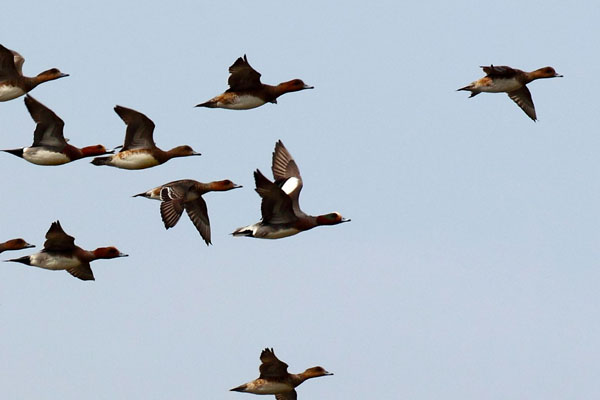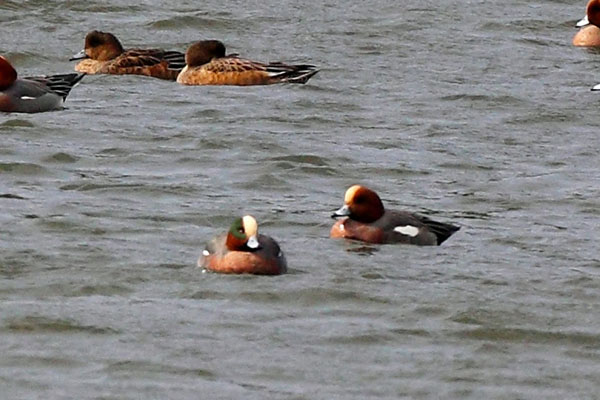Anas americana
IUCN
LCBasic Information
Scientific classification
- name:Anas americana
- Scientific Name:Grape-breasted duck,American Wigeon,Anas americana
- Outline:Waterfowl
- Family:Anseriformes Anseriidae
Vital signs
- length:46-53cm
- Weight:665-1330g
- lifetime:19 years
Feature
The male is easily distinguishable by his broad green eyeliner across the pale head, and the female and young are superficially similar to the red-necked duck.
Distribution and Habitat
Stray birds have been recorded in China only on the island of Taiwan. It breeds abroad in central and northern North America, winters in southern and Central America, and strays to East Asia.
It inhabits rivers, lakes, reservoirs and swamp waters, and inhabits coastal swamps and shallow bays in groups during non-breeding periods, often mixing with other river ducks.
Appearance
The head and upper body of the male bird are white, the top of the head is yellowish-white, from the eyes to the side of the neck with a wide green eye stripe, the front breast to the two sides of the flanks of the pink-brown, the tail under the cover of black, the rear side of the body with a white spot, a large white spot on the wing, the wing mirror dark green. The female is the same color as the red-necked duck, but the wing mirrors are dark green and the wings have large white spots. Iris brown, beak gray, tip black, feet blue-gray.
Details
Green brow duck is a river duck, also known as grape breast duck. Medium sized, much like the red-necked duck but slightly larger. The environment is often the same as that of the red-necked duck. In winter, it is found in lake areas, wetlands, freshwater rivers, lakes and coastal agricultural areas. They inhabit the tidal and intertidal zones of lagoons, bays and estuaries, beaches. During the breeding season, mallards prefer nearby swamps covered with large trees. Wet meadows that provide a variety of short grasses are the preferred sites for nesting.

The mallard breeds in northern and northwestern North America. Winter migrates to the East, West and South coasts of the United States, Central America. I like swampy areas. Daily activities, spent a lot of time swimming and hunting for food. Unsociable, rarely clustered, if food resources are abundant. Sometimes with mallards, mallards and other diving ducks. Ducks have webbed toes and are good at swimming and splashing in the water, but rarely dive, swim with their tails out of the water, and are good at foraging, splashing and mating in the water. Splashing in water is beneficial to the cleanliness and growth of feathers. Food is mainly insects and plants, eat aquatic insects, beetles, eat most of the stems, leaves, seeds and roots of aquatic plants.
During the breeding season, the mallard duck has a white forehead that is evident in its territory: usually a pair occupies the space of a pond. The breeding season is determined by winter temperatures and food abundance, so there is no set time. The nest site chosen by the female is hidden in tall grass on the land, far from water sources. Build a nest with grass and stems. Incubation lasts an average of 25 days, the male does not participate in the feeding of the brood, the young birds leave the nest after 37 to 48 days, the length of time also depends on the climate conditions of the habitat, experienced female birds, during different temperatures will be more or less delayed incubation.

In 2009, a greenbrow duck (AmericanWigeon) won out of 224 competitors as the winner of the 2010-2011 United States Federal Duck Stamp Art Competition. Each year, the U.S. Fish and Wildlife Service holds the contest and prints the winning entry on a $15 hunting stamp, which generates about $25 million a year for the conservation of wetlands in the National Wildlife Conservation System. In 2009, second place went to a pair of forest ducks (Aix sponsa) and third place went to Anas strepera. In the United States, all hunters over the age of 16 are required to purchase the "Migratory Bird Conservation and Hunting" stamp, or "American Duck Ticket," as a license to legally hunt, but the stamp cannot be used in the postal system. There are also many conservation workers and stamp collectors who buy these stamps to support conservation activities. Ninety-eight percent of the proceeds go to an organization called the Migratory Bird Conservation Fund. Since its inception in 1934, the campaign has raised $750 million and purchased nearly 6 million hectares of land to protect wildlife. There are already 550 national wildlife refuges in the United States, and this stamp is used in wildlife refuges throughout the country. And collecting this kind of stamp has also become a fashion.








